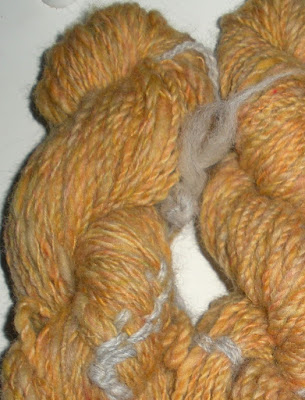Unless you are doing a gradient of some kind, the colors will mix and mingle as you spin them. You get this a bit with knitting variegated yarns, but less so - for the most part, the colors never "run" together like a bad watercolor.
Now, maybe I am just inexperienced, and, if I knew what I was doing I could get clean, clear color transitions. But I think that it is more than a matter of technique. If I want that kind of yarn, I need to dye it after I spin it.
So, for instance, if I buy wool that looks like this:
 |
| Yellow wool from Little Barn |
 |
| An early yarn made on my wheel, 2-ply |
Sometimes, the colors I get are completely unexpected though:
 |
| Jacob roving from Blue Flower Flock |
 |
| Three-ply Jacob skein |
 |
| Rough coopworth batt from Blue Moon Fiber Arts |
 |
| 2-ply skein on the niddy-noddy |
Here is a close-up:
Well, it is interesting. I don't know what I will make with it. Maybe I will only spin from uniform colors in the future, and leave variegated yarns to the dye vat.


















